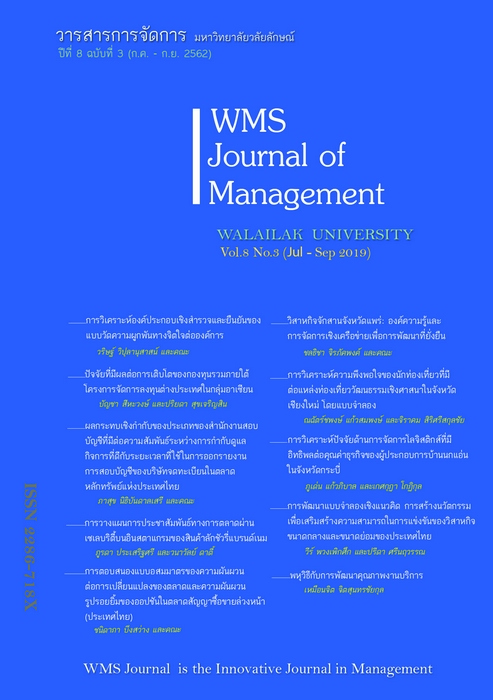Multivariate Ordered Probit Copula Analyzing Tourists’ Satisfaction of Religious and Cultural in Buddhist Temples in Chiang Mai by Multivariate Ordered Probit Copula Model
Main Article Content
Abstract
This paper aims to analyze tourists’ satisfaction of religious and cultural in Buddhist temples in Chiang Mai based on Multivariate Ordered Probit Copula model. We selected five temples with a distinctive religion and important monastery of Chiang Mai includes Wat Phra Sing, Wat Chedi Luang, Wat Phrathat Doi Suthep and Wat Jed Yod. The data of this study were collected from 400 tourists who ever visited all of four temples by using questionnaires. The results reveal that there are five variables that affect to the satisfaction tourists; the potential for attracting tourists, the potential to support tourism, management for tourism, personnel management and marketing strategy for tourism. However, we find that the management for tourism is the most important variable for all of these temples that increase tourists’ satisfaction. All of these results would be important information for developing the strengths and improving the weaknesses in each temple. In addition, the government, the private sector and local people realize to the importance of tourism for conserve, adjust and develop to be better.
Article Details
References
http://www.attm.biz/news/ 326755/%E0%B8%AA%E0% B8%96%E0A.-2555-2559.html
Bartolucci, F., Colombi, R. , & Forcina, A. (2007). An extended class of marginal link functions
for modeling contingency tables by equality and inequality constraints. Statistica Sinica, 17(2), 691-711.
Chaiwang, T. (2012). phrưttikam khō̜ng nakthō̜ngthīeo chāo Thai tō̜ kān thīeo wat nai čhangwat Chīang Mai. [Behavior of Thai Tourists Towards Temple Tours in Chiang Mai Province]. (Independent Study, Chiang Mai University, Thailand).
Hasegawa, H. (2010). Analyzing tourists' satisfaction: A multivariate ordered probit approach. Tourism Management, 31(1), 86- 97.
Khan, A. H., Haque, A., & Rahman, M. S. (2013). What Makes tourists satisfied? an empirical study on Malaysian Islamic tourist destination. Middle-East Journal of Scientific Research, 14(12), 1631-1637.
Khaosa-ard, M., Kruefoo, N., & Untong, A. (2005). mūnlakhā phœ̄m nai prathēt khō̜ng ʻutsāhakam thō̜ngthīeo khō̜ng prathēt Thai. [Retained value of the tourism industry of Thailand]. Research report. Chiang Mai: Social Research Institute Chiang Mai University.
Khomkaew, T. (2012). kān wikhro̜ khwāmphưngphō̜čhai khō̜ng nakthō̜ngthīeo thī mī tō̜ lǣng thō̜ngthīeo chœ̄ng watthanatham praphēt bōrānnasathān: kō̜ranī sưksā phra ʻārām lūang nai khēt ʻamphœ̄ mư̄ang čhangwat Chīang Mai. [The analysis of tourist satisfaction with cultural ancient remains: The case study of royal temples in Muang district, Chiang Mai Province]. Research Report. Chiang Mai: Maejo University.
Kongprasoet, T., Phatsakoncharat, S., & Ketawandi, P. (2014). patčhai thī mī ʻitthiphon tō̜ praphēt nakthō̜ngthīeo Yīpun nai čhangwat Chīang Mai. [Factors influencing type of Japanese tourists in Chiang Mai]. (Master’s Thesis, Chulalongkorn University, Thailand).
Marius, H., Ivan, K., Martin, M., Jun, Y., & Johanna G. (2018). Copula: An r package for fitting multivariate dependence with copulas. Retrieved from
http://copula.r-forge.r-project.org/
Morasin, K. (2005). kānčhat rāikān namthīeo čhangwat Chīang Mai samrap nakthō̜ngthīeo chāo Yœ̄raman. [Tour itineraries of Chiang Mai for German tourists]. (Independent Study, Master’s Thesis, Chiang Mai University, Thailand).
Mullins, L. J. (1985). The process of motivation, industrial management & data systems. Retrieved from https://i.org/ 10.1108/eb057393
Rainer, H., Kurt, H., Laura, V., & Alan, G. (2018). Mmvord: An R Package for Fitting Multivariate Ordinal Regression Models. Retrieved from https://cran.r-project.org/ web/packages/mvord/
Roger B. Nelsen. (2006). An Introduction to Copulas. USA: Springer Science & Business Media
Sadeh, E., Asgari, F., Mousavi, L., & Sadeh, S. (2012). Factors affecting tourist satisfaction and its consequences. Journal of Basic and Applied Scientific Research, 2(2), 1557-1560.
Shelly, M. W. (1975). Responding to social change. PA: Dowden Hutchison & Ross.
Sadhiandhammavit, S. (2011). khwāmkhātwang læ khwāmphưngphō̜čhai khō̜ng nakthō̜ngthīeo Thai thī mī tō̜ talātnam khlō̜ng lat mayom nai khēt taling chan Krung Thēp Mahā Nakhō̜n [Expectations and satisfaction of Thai tourists InfluencingKlong Lad Mayom Floating Market in Talingchan District, Bangkok]. (Independent Study, Rajamangala University of Technology Thanyaburi, Thailand).
Sanitwong Na Ayutthaya, S. (2007). khwāmkhātwang læ khwāmphưngphō̜čhai khō̜ng nakthō̜ngthīeo tō̜ kān bō̜rikān khō̜ng hōmsatē nai phāk tawanʻō̜k chīang nư̄a tō̜n lāng [Tourists’ expectations and their satisfaction with homestay services in lower - northeastern thailand]. (Master’s Thesis, Suranaree University of Technology, Thailand).
Silawanna, S. (2007). kānthō̜ngthīeo læ kān phœ̄iphrǣ phra phut sātsanā: botbāt khō̜ngwat nai khēt Krung Thēp Mahā Nakhō̜n kō̜ranī sưksā : wat bō̜wō̜n Niwēt wihān læ wat bēnčhama bō̜phit Dusit wanā rām [Tourism and dissemination of buddhism: The case study of Wat Bowon Niwet and Wat Benchamabophit Dusitwanaram in Bangkok]. (Independent Study, Mahidol University, Thailand).
Sema, S. (2012). khwāmphưngphō̜čhai nai kānthō̜ngthīeo Phatthaya læ bāng sǣn: kō̜ranī sưksā chapho̜ nakthō̜ngthīeo chāo Thai [The analysis of Thai tourists’ satisfaction: The case study of Pattaya city and Bangsean beach]. (Independent Study, Burapha University, Thailand)
Süli, E. & Mayers, D. (2003). An introduction to numerical analysis. United Kingdom: Cambridge University Press
The National Statistical Office (2016). kānthō̜ngthīeo [Tourism]. Retrieved from http://service.nso.go.th/nso/web/ statseries/statseries23.html
Thongma, W.,Leelapattana, W., & Nuanchan, T. (2011). kānphatthanākānthō̜ngthīeo chœ̄ng watthanatham yāng yangyư̄n khō̜ng chumchon chāo Čhīn nai phư̄nthī lumnam mǣ ngō̜n ʻamphœ̄ fāng čhangwat Chīang Mai [Sustainable cultural tourism development of Chinese community, Mae-ngon watershed area, fang district, Chiang Mai, Thailand].
Research Report. Chiang Mai, Thailand: Maejo University.
W. N. Venables & D. M. Smith (2018). An Introduction to R. Retrieved from https://cran.r- project.org/doc/ manuals/r-release/R-intro.pdf

